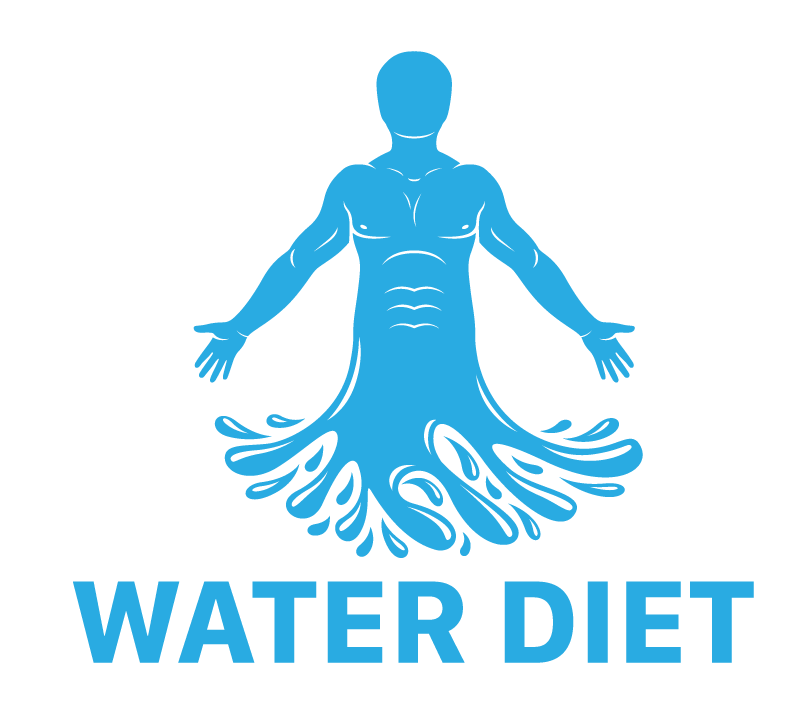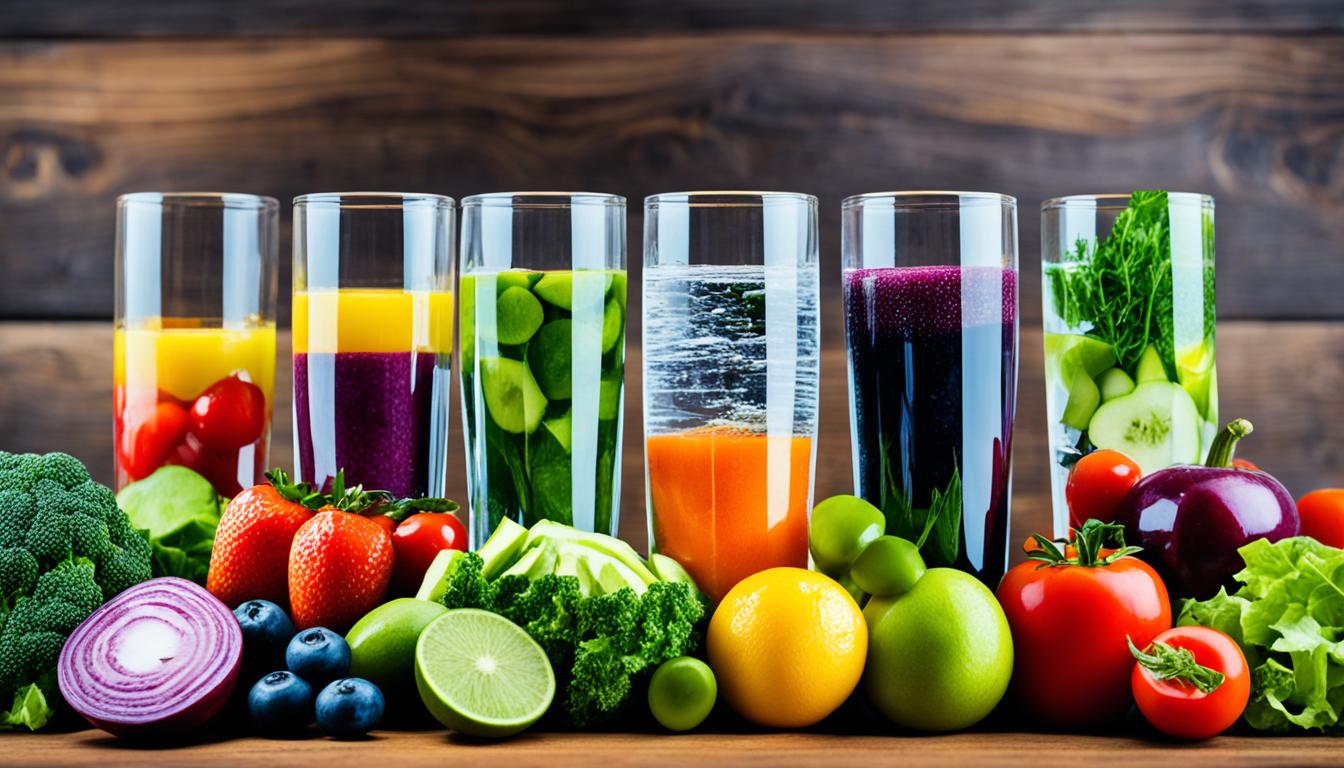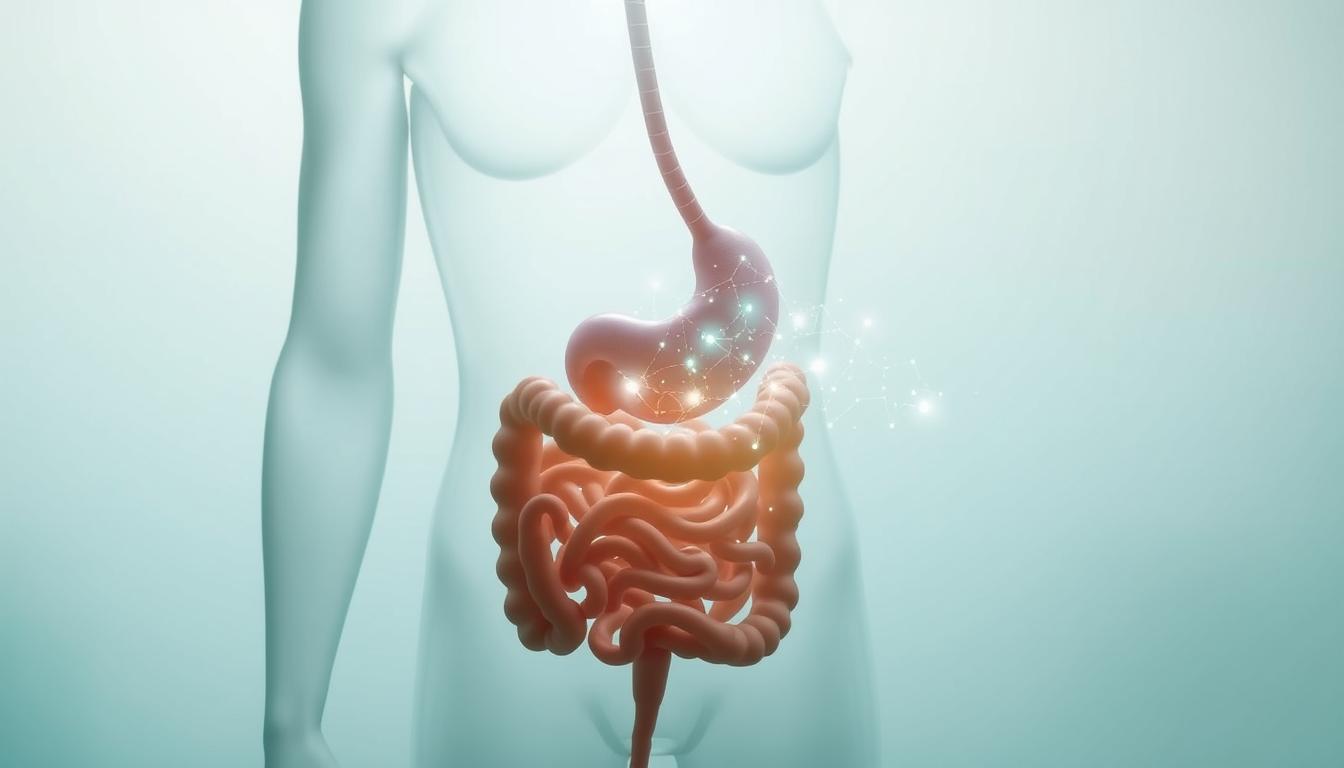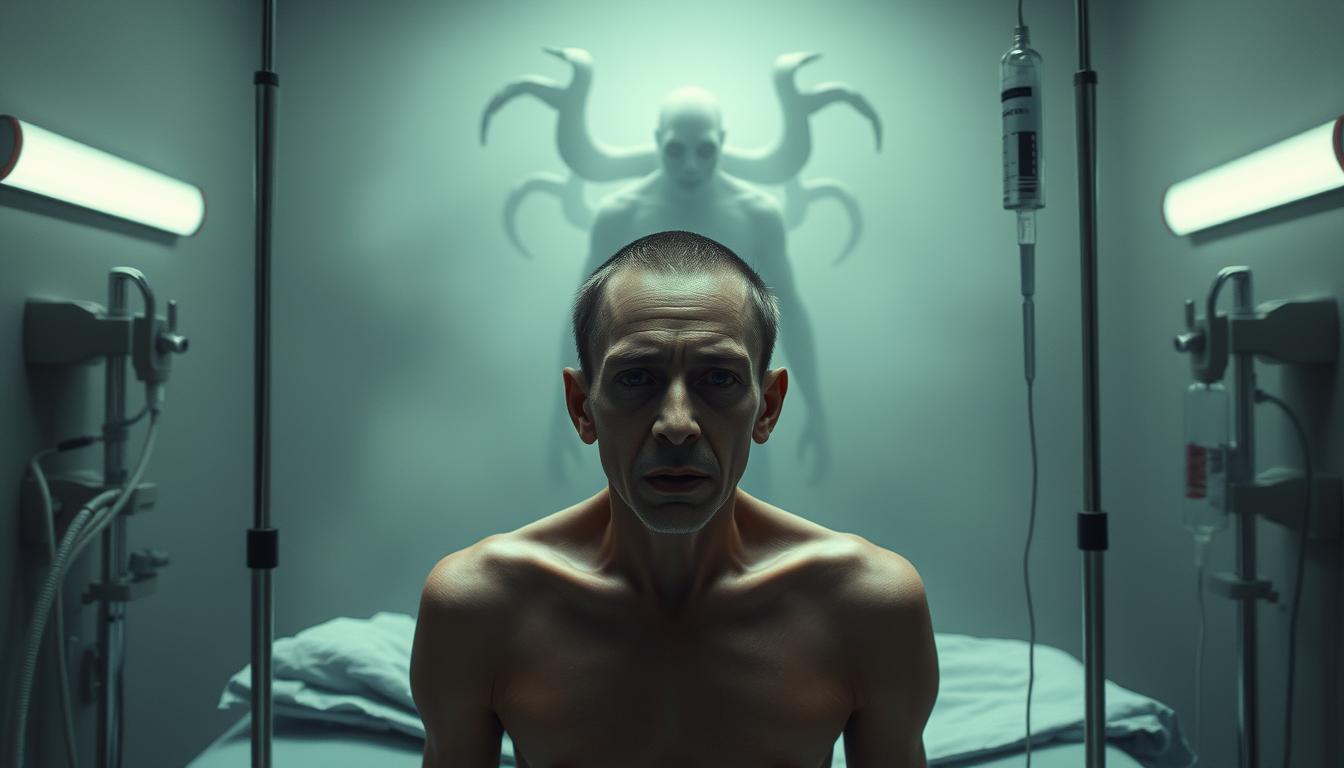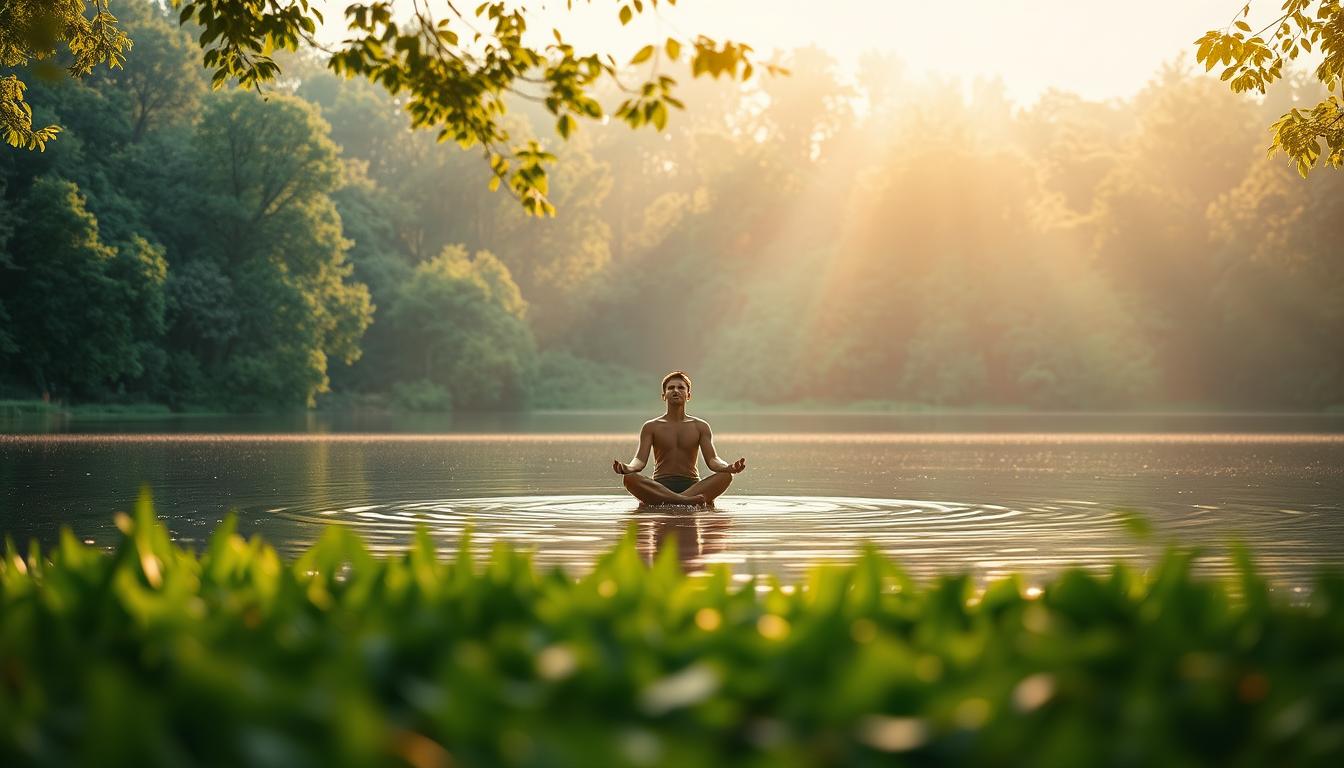Creating a water diet plan can boost your health and well-being. Focus on drinking enough water daily. This helps with managing weight and improving your digestion. Proper hydration brings many benefits1. Aim to drink half your body weight in ounces each day2.
Start your water diet by checking how much you drink now. Set goals according to your weight and how active you are. This approach prevents drinking too much water or under-doing it3. Add fruits and veggies to your meals. They’re full of water and key nutrients.
Stay on your water diet by carrying a water bottle, setting alerts, and adding flavors. For fun, drink water before meals. Those who did this lost around 15.5 pounds in 12 weeks2. Mix your water plan with a balanced diet for the best results.
Although a water diet can do a lot for you, it’s smart to talk to a doctor first. This is important if you’re not feeling well or have health issues. With good advice and a smart plan, you can use a water diet to reach your health goals.
Understanding the Benefits of a Water Diet for Your Health
Drinking enough water is key to staying healthy. A water diet means you increase how much water you drink and eat more foods full of water. This can make your body and mind feel better in many ways. For instance, it helps vital body functions work well, keeps your weight in check, and makes digestion smoother.
Improved Hydration and Its Impact on Overall Well-being
It’s very important to drink enough water to keep your body working right. Water helps keep your temperature normal, moves nutrients around, gets rid of waste, and helps you think clearly. If you don’t drink enough, you might feel tired, get headaches, or not think as well. Drinking more water can make your skin look better, help your joints move smoothly, and keep your kidneys healthy. There’s also evidence that not eating for a while (water fasting) can make you less likely to get certain diseases like diabetes, cancer, or heart problems4.
Potential Weight Loss Benefits of a Water-Rich Diet
Adding more water and foods with lots of water to your meals might aid in losing weight. This works because water-filled foods make you feel full. Also, drinking water before eating can lower your desire for food and the number of calories you take in. While you eat, staying hydrated can help your body burn fat better. Some research shows that not eating for a short time (water fasting) can improve the blood pressure and cholesterol of overweight or obese people4.
Enhancing Digestive Function Through Adequate Water Intake
Water is crucial for a well-functioning digestive system. It helps break down food, move it through your gut, and makes it easier to go to the bathroom. When you eat foods high in fiber, together with drinking enough water, this can help keep your digestive system on track. This is good for how your gut health overall.
Even though water fasting has some benefits, it can also be risky. These risks include losing the wrong type of weight, getting too dehydrated, and lowering your blood pressure too much when you stand up. People with gout or eating disorders should be extra careful with water fasting. Most plans for fasting suggest not doing it for more than a day. And there’s no clear advice on how to do a water fast, so it’s wise to talk to a doctor first3.
During a water fast, aim to drink 2-3 liters of water every day. Mineralized water is a good choice. When you start eating again after a fast, take it slow. Eating five small meals throughout the day is better than a few big ones. Before and after fasting, choosing a diet like the Mediterranean one is smart. This means eating whole grains, fresh fruits and vegetables, beans, nuts, and healthy proteins like fish3.
Water fasting might be good for your body in ways like clearing out old cell parts. And it could help with things like reducing stress, decreasing inflammation, balancing your hormones, and maybe even living longer. But there is still a lot we don’t know about how fasting works. Some groups, like children, the elderly, and people with certain eating disorders, should not try water fasting3.
Assessing Your Current Hydration Levels and Water Intake
Before starting a water diet plan, check how much water you drink and if you’re dehydrated. Signs of not drinking enough water include feeling thirsty, having dark urine, being tired, and a dry mouth. Studies say many older adults might be dehydrated. This can show through their blood being too concentrated. Also, older men might not feel as thirsty even if they need more water5.
Keep track of your water intake with a journal or an app. This can help you see where you need to drink more and make sure you reach your daily water goal. Health experts suggest aiming for pale yellow urine to know you’re drinking enough. Remember, about one-fifth of your daily water can come from food, with the rest from drinks6.
Everyone’s hydration needs change. It depends on things like how active you are, your environment, health, and if you’re pregnant or breastfeeding. Athletes should be careful. They need to drink enough but not too much to prevent a dangerous condition called hyponatremia6.
Here are some guidelines for checking your hydration:
- Your body is made up of 45 to 75% water7.
- Muscles are mostly water (70–75%), but in fat, it’s lower at 10-40%7.
- Adults typically need 1500 to 3100ml of fluids daily in moderate weather7.
- Most of your water should be from drinks with some coming from food7.
To stay hydrated, drink water throughout the day, including meal times and in between. Water is crucial for the body’s functions and makes up a big part of our weight. Always remember water is vital for our health6.
It’s crucial to stay hydrated for good health. Checking your water habits helps pave the way for a great diet focused on drinking more water.
Setting Realistic Goals for Your Water Diet Plan
It’s essential to set goals that fit your needs when starting a water diet. Look at how much water you should drink each day based on your weight and how active you are. This helps you stay hydrated without drinking too much water.
Determining Your Daily Water Intake Based on Body Weight and Activity Level
As a rule of thumb, you should drink half your weight in ounces each day2. So, if you weigh 150 pounds, aim for 75 ounces (about 9 cups) daily8. But, keep in mind, you might need more water if you work out a lot, live in a hot place, or have health issues. People who exercise a lot might need 1.5 to 2.5 cups more water than the standard calculation2.
Gradually Increasing Water Consumption to Avoid Overhydration
Starting slowly with more water helps your body get used to it and prevents drinking too much. Add one or two glasses more each day and see how you feel9. If you feel bloated or uncomfortable, cut back on the extra water. It’s also smart to talk with a doctor if you’re not sure how much water is right for you.
| Body Weight (lbs) | Recommended Daily Water Intake (oz) |
|---|---|
| 120 | 60 |
| 150 | 75 |
| 180 | 90 |
| 210 | 105 |
Setting achievable water intake goals and slowly increasing your water is key. This way, you can adjust your water plan to perfectly fit your body. Always listen to what your body tells you and make changes as needed. This approach will help you stay well-hydrated on your diet plan.
Incorporating Water-Rich Foods into Your Diet
Drinking water is great, but it’s not the only way to stay hydrated. Fruits and vegetables high in water content help keep you hydrated too. They are tasty and easy to add to your meals.
Exploring Fruits and Vegetables with High Water Content
Some fruits and veggies help a lot with staying hydrated. Take watermelon, for example. It’s 92% water and low in calories, with just 46 in a cup10. Strawberries pack a 91% water punch and are loaded with vitamins like C and folate10. Cantaloupe is 90% water and meets 120% of daily vitamin A in one cup10. Peaches, with 89% water, bring antioxidants and vit A & C10. Oranges, at 88% water, offer fiber, vitamin C, and potassium for a healthy heart and immune system10.
Vegetables also do their part in keeping you hydrated. Cucumbers lead the pack with 95% water and add nutrients like vitamin K and potassium10. Lettuce offers 96% water and is a good source of folate, vitamin K, and A, with very few calories10. Zucchini, at 94% water, provides many health benefits as well10.
Preparing Meals and Snacks Centered Around Hydrating Ingredients
Plan meals and snacks that fill you with water. Salads with lettuce, cucumbers, and tomatoes are great. Broths and soups, which are 92% water, can help with losing weight by reducing daily calories10.
Enjoy fruits and veggies with dips like hummus or yogurt for snacks. Skim milk, at 91% water, is full of essential vitamins and minerals. It’s perfect for smoothies or drinking on its own10. Smoothies made from water-rich fruits are also a tasty way to stay hydrated.
Adding plenty of water-rich foods to your diet can boost hydration. It also keeps your meals interesting and wholesome. Try out new recipes to make eating these foods fun and a part of your daily routine.
Strategies for Staying Hydrated Throughout the Day
It’s key to stay hydrated for good health. After all, our bodies are almost three-quarters water11. The standard advice is to drink 64 ounces (1,920 ml) or 8 cups daily. But, experts say men should aim for 125 ounces (3,700 ml) and women for about 90 ounces (2,700 ml) of fluids each day11. For water intake in the US, studies found adults on average drank 44 ounces (oz) a day between 2015 and 201812.
Carrying a Reusable Water Bottle and Setting Reminders
If you carry a reusable water bottle, you’re more likely to drink water. Choose one that’s tough, easy to wash, and holds enough water for your daily needs. To remember to drink up, set alerts on your phone or use an app that tracks your water. Apps like Water Reminder, Water Tracker Waterllama, or Water Drink Reminder are great for this12. For a more advanced option, the HidrateSpark PRO smart bottle at $69.99 uses Bluetooth to monitor how much you’re drinking. It also sends you reminders to sip more throughout the day12.
Infusing Water with Natural Flavors for Taste and Variety
If you don’t love plain water, try adding natural flavors. Drop in lemon, lime, or orange slices for a zesty touch. You can also use mint, basil, or cucumbers, or maybe even some berries. Not only does this make water tastier but these foods can also up your water intake. For example, lettuce is 96% water, and watermelon is 91% water11. Many fruits and veggies are mostly water, with percentages like 95% for celery and zucchini, 92% for cabbage, and even 90% for melons and berries12.
Replacing Sugary Beverages with Water or Unsweetened Alternatives
Drinks with added sugars, like soda or sweet teas, can dehydrate you and pump extra calories into your body. Consuming too much sugar is bad news, often leading to weight issues, diabetes, and heart ailments11. Swap these out for water or low-sugar choices to hit your hydration and health targets. Consider seltzer water with a bit of juice, herbal teas without sugar, or milk with low fat as good choices. A 2019 study found that upping your water intake could aid in weight loss, which is great news for those looking to shed some pounds12.
| Healthy Beverage Swaps | Benefits |
|---|---|
| Water infused with fruits or herbs | Natural flavor, no added sugar, hydrating |
| Unsweetened herbal teas | Antioxidants, variety of flavors, calorie-free |
| Sparkling water with a splash of fruit juice | Low in calories, refreshing, hydrating |
| Low-fat milk | Calcium, protein, vitamin D, hydrating |
By following these steps and swapping out unhealthy drinks for better ones, you can drink more water and boost your health. In a study, people who drank 18 ounces of water before bed upped their daily intake from 44 to 68 ounces. This shows how a simple habit can make a big difference12.
How to Create a Water Diet Plan for Optimal Health
Creating a plan for your health through a water diet is key. You should think about your needs and habits. Decide how much water you should drink each day, considering your weight, how active you are, and the weather2. Drinking half of your body weight in water daily is a good guideline2.
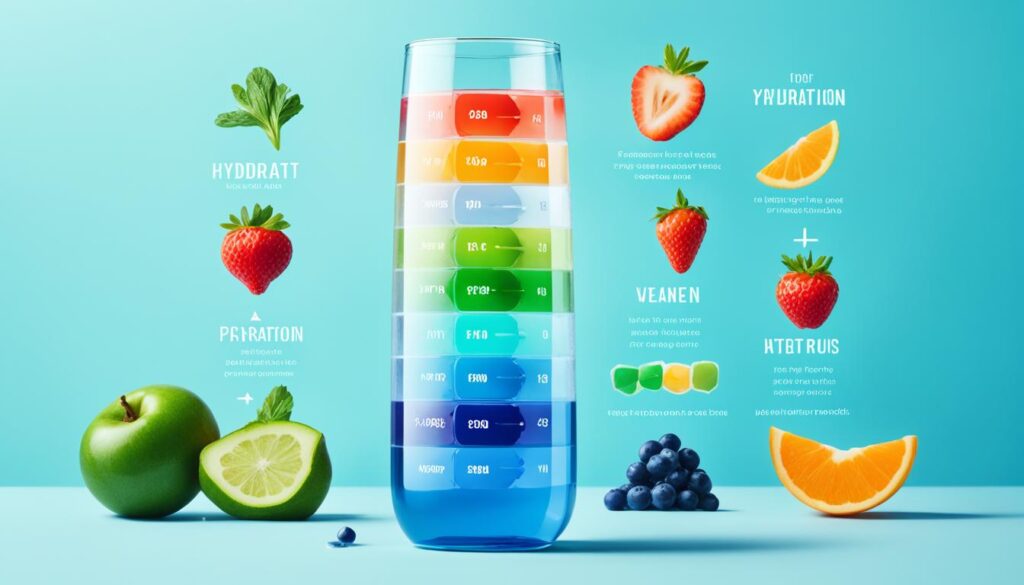
To meet your water goal, break it into smaller amounts you can drink throughout the day. Try having a glass when you wake up, before meals, and during the day. Adjust when you drink water as you feel thirsty or when your day’s activities change.
Designing a Personalized Water Intake Schedule
Here are some ideas for fitting water into your day:
- Drink a glass of water first thing in the morning to rehydrate after sleep
- Sip water throughout the day rather than drinking large amounts at once
- Increase water intake before, during, and after physical activity
- Set reminders or use a water tracking app to stay on schedule
Balancing Water Consumption with a Nutritious, Well-Rounded Diet
Hydration should go with a balanced diet. Besides drinking water, eat foods like lean proteins, complex carbs, and good fats. Pick fruits and veggies that are full of water to help you stay hydrated and to get important nutrients. Here are some examples of hydrating options:
| Fruits | Vegetables |
|---|---|
| Watermelon | Cucumber |
| Strawberries | Lettuce |
| Cantaloupe | Celery |
| Grapefruit | Zucchini |
Stay away from processed foods that are high in salt. They can make you less hydrated and lower your diet success3.
Monitoring Progress and Adjusting Your Plan as Needed
Keep an eye on how you’re doing with your water diet and make changes when necessary. Listen to your body; if you’re thirsty or your urine is dark, drink more water. If it’s hard to drink as much as you need, try setting smaller goals and then gradually increasing them3. Be proud of your improvements and go easy on yourself as you get used to better eating habits and a steady diet of water.
While a water diet is good for managing weight and health2, it’s smart to talk to a doctor before you make big changes or fast for more than a day3. By following your hydration plan closely, making necessary tweaks, and checking your progress often, you can have a personal plan that enhances your health for the long run.
Overcoming Common Challenges and Obstacles in a Water Diet
Starting a water diet can be hard. You might forget to drink enough water, think plain water tastes bad, or get stressed about how much you need to sip daily. A 2005 study by Manz F and Wentz A showed people in the United States and Germany didn’t drink enough water5.
To tackle these challenges, here are some tips:
- Set alerts on your tech gadgets to remind you to sip water often.
- Try adding fruits, veggies, or herbs to your water for a tastier sip.
- Use a water bottle with marks to keep track of how much you’ve drank.
- Team up with someone or find a group where you can swap advice and stay motivated.
Just do your best. Each drink of water, no matter how small, brings you closer to your goal. Water habits changed for the better from 1965 to 2002, showing people understand the value of good hydration5.
Persistence pays off. Staying hydrated offers many health benefits. It can even change how our body’s cooling system works as we get older5.
The American Academy of Pediatrics tells us to drink plenty of water when we’re active, especially in the heat5.
With these strategies in mind, you can beat the challenges of a water diet. This will lead to better health and feeling your best.
Combining a Water Diet with Regular Exercise for Maximum Benefits
Working out often and drinking plenty of water helps you stay healthy. But remember, you need to drink more water when you exercise. The American Council on Exercise suggests a water intake plan for before, during, and after your workout13.
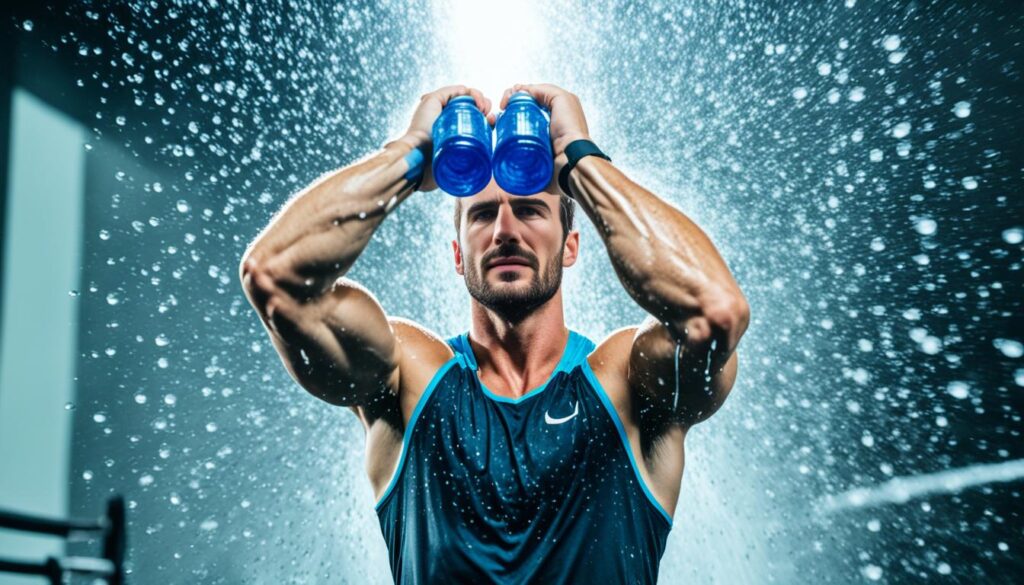
Staying Hydrated During Physical Activity
Hydrating right is key for top sports performance and avoiding issues like tiredness and cramps. A study in 2005 showed that kids who don’t drink enough can have trouble thinking straight during sports5. Drink water not just after but also before and during your exercise. It helps your body stay cool, feeds your muscles, and clears out waste.
Replenishing Electrolytes Lost Through Sweating
You lose important minerals when you sweat a lot, like sodium and potassium. For exercise under an hour, water is fine. But for longer or harder workouts, you might need a sports drink or supplements13. Foods such as bananas and coconut water are rich in these lost minerals and can help too.
Doctors say fast, long-lasting changes are the secret to helping people. Adding a water diet and workouts to your life can bring you big health boosts. They recommend, for a 10-day challenge, drinking half your weight in water ounces daily. Doing this with 20-30 minutes of rebounding can help your body clean out toxins through the lymph system14.
Being smart about water and exercise means you can reach your health goals. Always pay attention to how your body feels. Adjust your plan as necessary. If you’re not sure what’s best for you, talk to a doctor.
Maintaining Long-Term Success with Your Water Diet Plan
Starting a water diet means making a big life change, not just a quick fix. It’s all about staying healthy for the long haul. Changing how you drink and think about water is key. Small daily changes build a solid path to continue winning over time.
Establishing Sustainable Hydration Habits
Adding water to your life every day is crucial for a lasting water diet. Drink a glass when you wake up, and keep sipping through meals and beyond. Picking water over soft drinks and coffee is a smart move. Don’t forget to have a water bottle with you always. Foods with high water content are great too. These steps make sure staying hydrated feels normal, not work.
Experts agree, aim for 2-3 liters of water each day for a healthy lifestyle3. This goal is perfect for keeping your water diet on track. It helps you stay hydrated and enjoy all the good that comes with a focus on water.
Regularly Evaluating and Updating Your Water Diet Goals
Over time, how much water you need might change. Things like how often you work out or the weather play a big part. Gradually losing weight can help you keep it off better than doing it quick3. Keep an eye on your water plan and adjust as life changes. This keeps your goals current and supports ongoing success.
Moving forward is easier when you celebrate wins and set new targets. If hitting your water targets gets tough, talking to a pro can help. They offer tips that fit just for you, tackling any obstacles together.
| Strategy | Benefit |
|---|---|
| Drink water first thing in the morning | Rehydrates the body after a night’s sleep |
| Sip water during meals | Aids in digestion and promotes feelings of fullness |
| Carry a reusable water bottle | Encourages frequent hydration throughout the day |
| Choose water-rich foods | Boosts overall water intake and provides essential nutrients |
Use these tips to keep moving forward with your water diet. Checking in on your progress regularly is crucial. Making hydration a daily part of your life is the real secret to lasting success.
“Water is the driving force of all nature.” – Leonardo da Vinci
Water is life’s foundation. By diving into the world of water, you’re choosing a brighter path. Make every drink of water a step towards a healthier future.
Consulting with Healthcare Professionals for Personalized Guidance
Starting a water diet can be good for your health, but it’s smart to talk to medical advice for water diet plans with a pro first. Your doctor or a dietitian can give you personalized hydration guidance based on things like your age, gender, health, and the medicines you’re taking. They’ll sort out how much water you really need and how to go about a water diet safely. They’ll also keep an eye on how you’re doing. Usually, experts say not to fast for more than a day and to drink 2-3 liters of water every day you fast3.
If you’re dealing with health issues already, it’s super important to check with consulting healthcare professionals before you make any big hydration changes. They might say it’s best not to do hard workouts during a fast. This can help prevent feeling tired, dizzy, weak, or sick when fasting isn’t right for you3. For those over 65 who do half an hour of exercise each day, the Optimal Weight 5 & 1 Plan could work well. It has 6 small meals, adding up to 800 to 1,000 calories in a day15.
When you talk to consulting healthcare professionals, you can look at different OPTAVIA plans made for certain groups, such as older adults or those with diabetes, or if you have different weight loss goals. The Optimal Weight 4 & 2 & 1 Plan involves 4 Fuelings, 2 Lean & Green™ meals, and 1 healthy snack. It’s about 1,100 to 1,300 kcal/day. On the other hand, the Optimal Weight 5 & 2 & 2 Plan gives you 5 Fuelings, 2 Lean & Green meals, and 2 healthy snacks. You’d be eating between 1,300 to 1,500 calories each day15. The CDC suggests going slow with weight loss to keep the weight off3.
FAQ
What are the benefits of a water diet for overall health?
How much water should I drink daily for optimal hydration?
What are some water-rich foods I can include in my diet?
How can I make drinking water more enjoyable?
How can I track my water intake and progress on a water diet?
How does exercise affect my water intake needs?
Should I consult with a healthcare professional before starting a water diet?
Source Links
- https://www.healthline.com/nutrition/48-hour-fasting
- https://www.wikihow.com/Do-a-Water-Diet
- https://www.medicalnewstoday.com/articles/319835
- https://www.healthline.com/nutrition/water-fasting
- https://www.ncbi.nlm.nih.gov/pmc/articles/PMC2908954/
- https://www.mayoclinic.org/healthy-lifestyle/nutrition-and-healthy-eating/in-depth/water/art-20044256
- https://www.ncbi.nlm.nih.gov/pmc/articles/PMC4207053/
- https://www.wikihow.com/Perform-a-Water-Fast
- https://yoursimplynutrition.com/blog/setting-smart-goals/
- https://www.healthline.com/nutrition/19-hydrating-foods
- https://www.healthline.com/nutrition/how-to-drink-more-water
- https://www.everydayhealth.com/dehydration/smart-tips-for-staying-hydrated-throughout-the-day/
- https://www.healthline.com/health/fitness-exercise-eating-healthy
- https://www.tonyrobbins.com/health-vitality/the-10-day-pure-energy-challenge/
- https://optaviamedia.com/pdf/health-professional/OPTAVIA_DOC_Overview-for-HP.pdf
